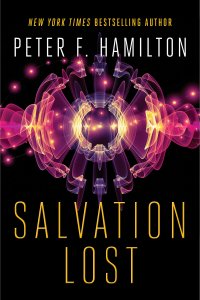Paul Di Filippo Reviews Salvation Lost by Peter F. Hamilton
 Salvation Lost, Peter F. Hamilton (Del Rey 978-0399178856, 512pp, $32.00, hardcover) October 2019
Salvation Lost, Peter F. Hamilton (Del Rey 978-0399178856, 512pp, $32.00, hardcover) October 2019
I’m always chuffed when a review of mine provides a sentence that is deemed blurb-worthy by a publisher. This just happened with my review of Peter Hamilton’s novel Salvation from 2018. I appear on the back cover of the brand-new sequel, Salvation Lost, saying, “It’s a bravura performance from start to finish… Hamilton is juggling chainsaws while simultaneously doing needlepoint over a shark tank. It’s a virtuoso treat, and I for one can hardly wait for Salvation Lost.”
Seeing this, I thought to myself, Maybe I need not even bother reviewing the sequel, for what else could I say that conveys the pleasures of Hamilton’s writing better? But upon further consideration, I realized that any additional chance to alert folks to Hamilton’s fine work must be undertaken. So, realizing I probably won’t come up with anything quite so quotable again, I’ll nonetheless plunge ahead.
To recap the multiplex setup of the first book in a horrendously simplistic fashion: the year 2204 sees humanity flourishing, with stargates leading to approximately fifty extrasolar colonies. Of course, our original solar system is also threaded with portals. Technology of all sorts is highly advanced, especially in the biological realm, thanks to the restorative and enhancement “Kcell” processes gifted to us by some friendly aliens, the Olyix. But in contrast to this near-Utopia, Hamilton also shows us a far-future timeline where humanity is a struggling, hunted remnant of itself, and the Olyix are hostile. How did we get from one era to the other? That’s the enigma that begins to be explored in this volume.
I should say at this point that Salvation Lost does not suffer from the infamous “book two in a series” longueurs. Without giving too much away, I will reveal that Hamilton upends the stability of both his timelines. Earth is effectively destroyed by an Olyix invasion, and the era known as “56th Year AB” has all its assumptions about the state of their warfare with the Olyix turned inside out. This is bold and fearless plotting, and I anticipate just as many thrilling revelations and stunning reversals in the concluding book three, The Saints of Salvation.
Back to the plot. Humanity of 2204 now realizes that the Olyix have long planted spies among them, fifth columnists who now become active saboteurs in the forefront of the invasion from space, which consists of a giant harvesting ship and many smaller attack vessels. What the Olyix intend is to capture as many humans as possible, “cocooning” them through Kcell subversion, and to bring them across countless millennia to the Omega Point as a tribute to the God they believe exists there. The bulk of the action in this thread is a playing-out in intricate detail of the resistance and onslaught, a kind of classic Wellsian invasion scenario times a thousand.
Hamilton jumps around among a dozen or so perspectives, from the high and mighty movers and shakers such as the stargate CEO Ainsley Zangari and the soldiers on the battlefronts like Callum Hepburn and Yuri Alster, down to the “average citizen.” My favorite set of characters on this lower tier is a bunch of mooks who call themselves the Southwark Legion. They are lowlife London criminals just out for a quick profit through any illegal operation. Their dialogue and natures provide some comic relief. But when the invasion comes, they find their selfishness is no longer a survival mechanism. My favorite amongst them is Ollie, and the book concludes with an interesting path forward for him.
Meanwhile, our focus in the galactic future is on two lovers, Dellian and Yirella. They have constructed a “honeypot”-style trap for the Olyix, by engineering into being an entire fake civilization. (Just one of the myriad startling concepts Hamilton spins off.) But when the Olyix finally arrive, not all goes according to human expectations—in part thanks to the arrival of a weird ally from an unexpected quarter.
Hamilton excels at giving us the quotidian textures of the everyday lives of his people, as strange as such new daily realities might be to us. But he also never forgets to include the gosh-wow sensawunda stuff, as here:
Perth was the first city. A clean urban jewel sitting on Australia’s coast. It was protected by eight interlocking oval shields that stretched for seventy kilometres end to end, and forty deep. High waves were already slapping at the waterside edge of the shields when seven Deliverance ships came sliding out of the wounded sky at hypersonic velocity, curving around as they lost speed, to deliver a salvo of sonic booms that went unheard by the residents below. The big streamlined craft spread out to encircle the city, then landed a kilometre from the shield boundary, with one coming down on Rottnest Island. One by one they fired energy beams at the shield domes.
Every human on Earth accessing the feed held their breath. The air above the shield began to glow as static webs danced around the strike points, shivering down the dome to ground out in a continuous roar. Columns of searing air fountained up high into the atmosphere, mushrooming out at gale force to repel the clouds rushing in from the sea. The domes themselves began to glow with crimson stress as their enhanced atomic bonds were abused by the severe energy input. But they held.
How much like Doc Smith’s primordial prose this is, except polished and amped up in light of an additional century of scientific and science fictional progress. So long as there are writers like Hamilton who can blend the core and eternal human bits with the ultrahuman visionary stuff, science fiction will flourish.
Anyone who has enjoyed Stephen Baxter’s Xeelee saga or Gregory Benford’s Galactic Center sequence will find comparable joys here.
 While you are here, please take a moment to support Locus with a one-time or recurring donation. We rely on reader donations to keep the magazine and site going, and would like to keep the site paywall free, but WE NEED YOUR FINANCIAL SUPPORT to continue quality coverage of the science fiction and fantasy field.
While you are here, please take a moment to support Locus with a one-time or recurring donation. We rely on reader donations to keep the magazine and site going, and would like to keep the site paywall free, but WE NEED YOUR FINANCIAL SUPPORT to continue quality coverage of the science fiction and fantasy field.







